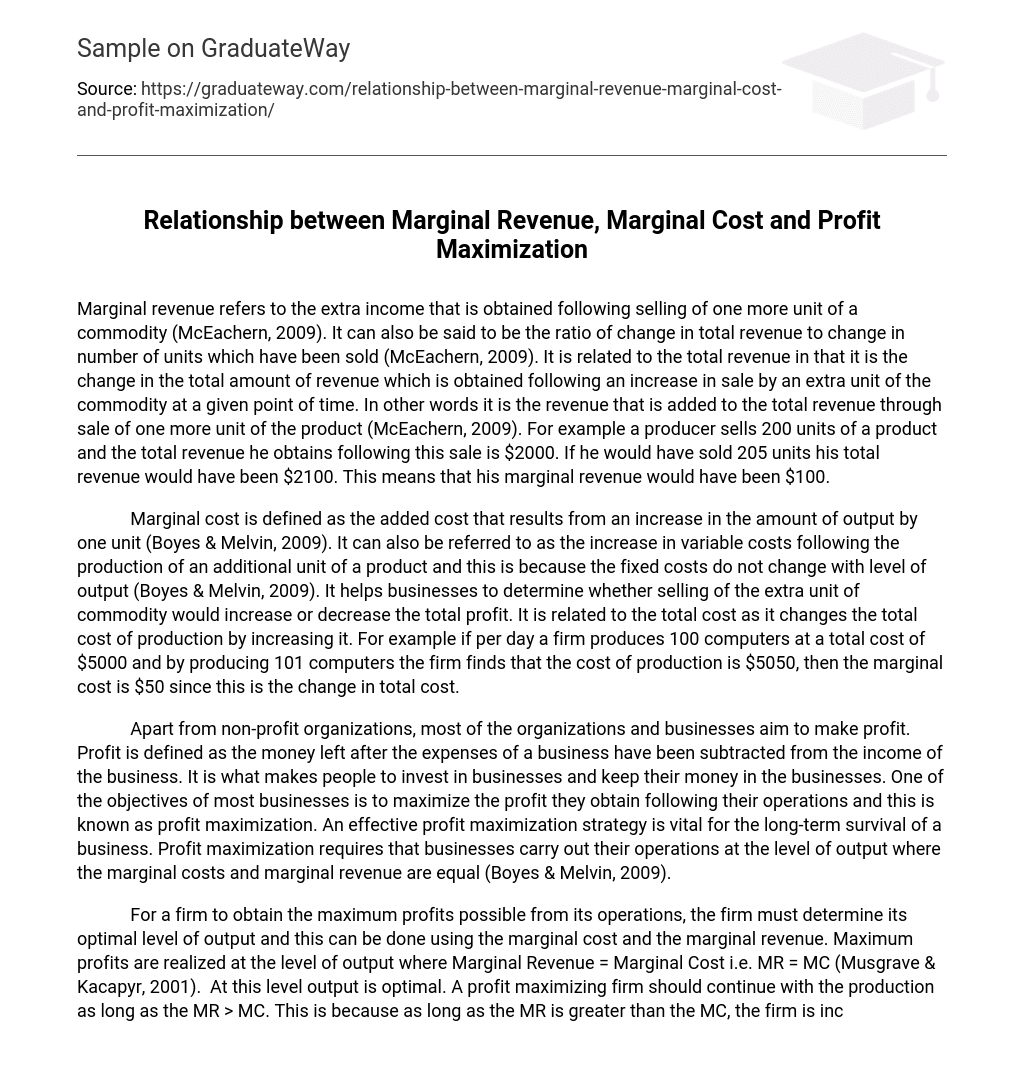Marginal revenue refers to the extra income that is obtained following selling of one more unit of a commodity (McEachern, 2009). It can also be said to be the ratio of change in total revenue to change in number of units which have been sold (McEachern, 2009). It is related to the total revenue in that it is the change in the total amount of revenue which is obtained following an increase in sale by an extra unit of the commodity at a given point of time. In other words it is the revenue that is added to the total revenue through sale of one more unit of the product (McEachern, 2009). For example a producer sells 200 units of a product and the total revenue he obtains following this sale is $2000. If he would have sold 205 units his total revenue would have been $2100. This means that his marginal revenue would have been $100.
Marginal cost is defined as the added cost that results from an increase in the amount of output by one unit (Boyes & Melvin, 2009). It can also be referred to as the increase in variable costs following the production of an additional unit of a product and this is because the fixed costs do not change with level of output (Boyes & Melvin, 2009). It helps businesses to determine whether selling of the extra unit of commodity would increase or decrease the total profit. It is related to the total cost as it changes the total cost of production by increasing it. For example if per day a firm produces 100 computers at a total cost of $5000 and by producing 101 computers the firm finds that the cost of production is $5050, then the marginal cost is $50 since this is the change in total cost.
Apart from non-profit organizations, most of the organizations and businesses aim to make profit. Profit is defined as the money left after the expenses of a business have been subtracted from the income of the business. It is what makes people to invest in businesses and keep their money in the businesses. One of the objectives of most businesses is to maximize the profit they obtain following their operations and this is known as profit maximization. An effective profit maximization strategy is vital for the long-term survival of a business. Profit maximization requires that businesses carry out their operations at the level of output where the marginal costs and marginal revenue are equal (Boyes & Melvin, 2009).
For a firm to obtain the maximum profits possible from its operations, the firm must determine its optimal level of output and this can be done using the marginal cost and the marginal revenue. Maximum profits are realized at the level of output where Marginal Revenue = Marginal Cost i.e. MR = MC (Musgrave & Kacapyr, 2001). At this level output is optimal. A profit maximizing firm should continue with the production as long as the MR > MC. This is because as long as the MR is greater than the MC, the firm is increasing more of its revenue than it is increasing its costs (Musgrave & Kacapyr, 2001). This production should continue until the MR = MC at which point the firm will have known that it has reached its optimal output level and thus its profits are at a maximum level (Musgrave & Kacapyr, 2001). In cases where there is no output level at which MR = MC, to determine the optimal level of output the firm can take the highest output level at which MR > MC and this would act as the optimal level of output for that firm (Musgrave & Kacapyr, 2001). If such a firm produced an extra unit of product beyond this level there would not be any maximization of profits.
In a situation where a firm finds that its marginal revenue is greater than its marginal cost, it means that producing one more unit of a product increases the revenue more than it increases the costs and thus producing the extra unit would increase the profit (Boyes & Melvin, 2009). In such a situation the firm should produce more as this would increase the profits. On the other hand, if a firm that seeks to maximize its profits finds that its marginal revenue is less than its marginal cost, the firm should not produce more products as this would decrease the profits. This is because when the marginal revenue is less than the marginal cost, it means that the production of an extra unit of commodity costs more than the revenue that is gotten following the sale of that extra unit and thus the production of that unit decreases the profits (Boyes & Melvin, 2009).
References
Boyes, W. J. & Melvin, M. (2009). Fundamentals of economics. Mason, OH: Cengage Learning.
McEachern, W. A. (2009). Economics: A contemporary introduction. Mason, OH: Cengage
learning.
Musgrave, F. & Kacapyr, E. (2001). Purchasing. New York, NY: Barron’s Educational Series,
Inc.





